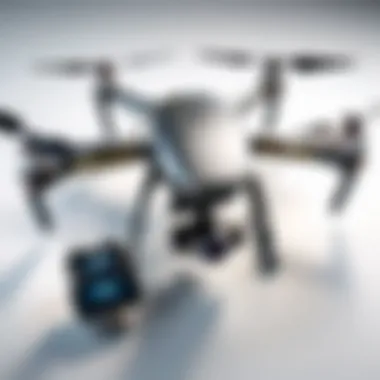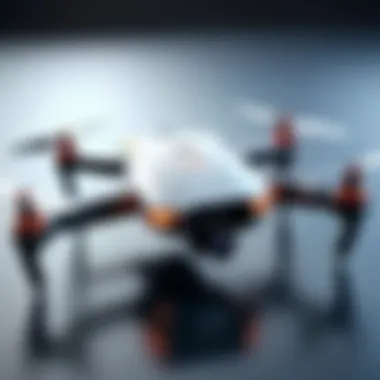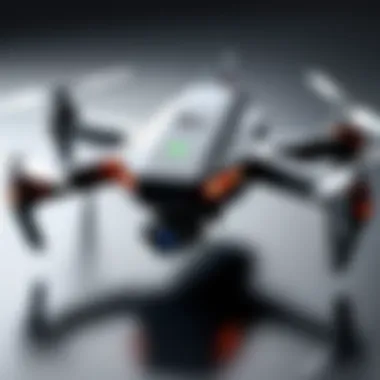Exploring the Best Miniature Drones: A Comprehensive Guide


Intro
The rapid evolution of drone technology has led to the emergence of numerous miniature drones. These small yet powerful tools have found applications in various fields, from aerial photography to agriculture. Understanding the nuances of these devices is crucial. Whether you're a tech professional or a drone enthusiast, grasping their features, performance, and applications can guide smarter decisions when investing in one.
Miniature drones come packed with innovative features that can cater to specific needs. They are often equipped with high-quality cameras, GPS, and advanced stabilization systems. These attributes make them versatile for both hobbyists and professionals.
This guide offers a comprehensive look at the best miniature drones available today. We will analyze their specifications, evaluate their performances, and highlight their unique aspects.
Preamble to Miniature Drones
Miniature drones have become a pivotal force in today’s tech landscape. Their compact size and versatility make them suitable for a wide array of tasks, from hobbyist photography to industrial inspections. Miniature drones attract attention due to their increasing accessibility and capabilities. Understanding this topic is essential for IT professionals and tech enthusiasts who follow innovations in the drone industry.
In this guide, we will delve into the intricacies of miniature drones, highlighting important features and considerations that potential buyers and users should keep in mind.
Definition and Overview
Miniature drones, often referred to as UAVs or quadcopters, are small flying devices that can be remotely controlled or can operate autonomously. They are equipped with sensors and cameras, allowing for real-time data gathering and surveillance. Their lightweight structure makes them ideal for a variety of uses, including aerial photography, mapping, and recreation.
The term "miniature" typically refers to drones that weigh under 2 kilograms. Despite their lightweight design, these drones pack advanced technology that yields impressive results in data collection and flight performance.
History of Miniature Drones
The evolution of miniature drones has a rich history, beginning in the early 20th century. The concept of unmanned aerial vehicles dates back to World War I when experimental drones were developed for target practice. The technology progressed slowly, mainly for military applications.
In the early 2000s, miniature drones started to emerge for civilian use, thanks to advancements in technology and miniaturization. Companies like Parrot and DJI played significant roles in popularizing consumer drones. These advancements made it possible for hobbyists and professionals alike to benefit from aerial imaging and monitoring.
By the 2010s, miniature drones became a common sight, with improved flight stability, better cameras, and user-friendly controls. This timeline highlights how far the industry has come and sets the stage for understanding the current landscape of miniature drones.
Technological Advancements in Drone Design
Technological advancements in drone design play a pivotal role in shaping the capabilities and usability of miniature drones. Understanding these developments provides insights into the efficiency, performance, and practicality of drones in various applications. As the field continues to evolve, the significance of improved designs becomes evident.
Material Innovations
The materials used in constructing miniature drones have drastically evolved over the years. Traditional materials like plastic and metal are now supplemented or replaced with advanced composites such as carbon fiber and lightweight polymers. These innovations lead to several benefits:
- Weight Reduction: Lighter materials contribute to increased flight efficiency. A lighter drone can achieve longer flight times due to reduced battery load.
- Durability: Modern materials are often more resistant to impacts and harsh conditions, enhancing the overall lifespan of drones.
- Flexibility in Design: The ability to mold and fabricate materials allows for more complex and aerodynamically efficient shapes, improving the performance.
Such advancements create a robust framework, allowing drones not only to perform better but also to be more adaptable to user needs.
Miniaturization of Components
Miniaturization is a crucial trend in drone technology, as it directly impacts performance and functionality. As electronic components decrease in size without sacrificing power or capability, drones can incorporate features that were once deemed impractical.
Some important aspects of this trend are:
- Compact Design: Smaller components mean that drones can be designed to be more compact, making them easier to transport and operate in tight spaces.
- Improved Functionality: With miniaturized sensors and cameras, drones can offer high-resolution imaging and advanced navigation systems, enhancing their capabilities for both recreational and professional uses.
- Energy Efficiency: Smaller, more efficient components lead to reduced energy consumption, allowing drones to operate for extended periods without the need for frequent recharging.
The trend of miniaturization exemplifies innovation at its core. As these components advance, they not only elevate the performance standards but also broaden the scope of applications for miniature drones.
Investing in high-quality materials and components is essential for anyone considering purchasing a miniature drone.
By considering technological advancements in drone design, users can make more informed choices, ensuring they select drones that best meet their needs and expectations in an increasingly competitive market.
Key Features of the Best Miniature Drones
The selection of a miniature drone goes beyond just brand recognition. It is essential to understand the core features that distinguish quality models from inferior ones. This section explores critical elements such as camera quality, flight time, battery life, and connectivity. These features not only enhance user experience but also determine the drone's overall effectiveness for specific applications.


Camera Quality
In today's market, a miniature drone’s camera quality is one of the most significant factors to consider. Higher resolution cameras lead to sharper images and clearer video, making them particularly appealing for recreational users as well as professionals. Drones equipped with 4K cameras often cater to filmmakers and content creators seeking high-fidelity imagery.
However, resolution is not the only consideration. The following aspects are important as well:
- Field of View (FoV): A wider FoV enables users to capture more expansive landscapes without needing to reposition the drone frequently.
- Stabilization Systems: These systems, such as gimbal stabilization, are crucial in providing smooth video footage, especially during flight maneuvers.
- Low Light Performance: Drones with good performance in dim environments are advantageous for evening or night-time operations.
Thus, evaluating camera specifications in the context of intended use remains key for buyers.
Flight Time and Battery Life
Flight time remains a critical specification for any miniature drone. Average flight time typically ranges from 20 to 30 minutes, depending on the drone’s size, weight, and battery capacity. Drones designed for longer flights use advanced LiPo batteries, which provide higher energy densities, thus extending flight duration. However, optimally managing flight time requires consideration of multiple factors:
- Battery Charge Cycles: Frequent charging can diminish battery health over time. Understanding how long batteries last before needing replacement is vital for long-term usage.
- Usage Patterns: Users engaging in intensive maneuvers might experience quicker battery depletion, which necessitates planning for extra batteries on longer excursions.
- Weight and Accessories: Adding payloads—such as cameras or sensors—can impact battery life. The more weight a drone carries, the shorter its flight time becomes.
Consequently, understanding flight time and battery performance can greatly influence the overall satisfaction of drone operation.
Range and Connectivity
The operational range of a miniature drone refers to how far it can fly away from its controller while still maintaining a reliable connection. This factor varies significantly among models, influenced by technologies such as radio frequency (RF) and Wi-Fi.
Consider such elements when assessing range and connectivity:
- Controller Technology: Many users prefer drones that utilize leading edge technologies such as 2.4 GHz or 5.8 GHz because they offer less interference and improved connectivity.
- Real-time Video Feed: A drone's ability to transmit live video back to the controller enhances the user experience, especially for aerial photography, where real-time monitoring helps in framing shots.
- GPS Functionality: Drones equipped with GPS features allow for more stable flight paths and return-to-home functions, thus increasing usability and safety.
This feature is essential in recreational use and commercial applications, allowing pilots to maintain control over longer distances and navigate complex environments.
Understanding these aspects can help users choose the right drone to match their specific needs while optimizing their flying experience.
Top Miniature Drones on the Market
Understanding the landscape of miniature drones is essential for anyone interested in aerial technology. These drones have become increasingly popular due to their compact size and versatility. In this section, we will examine some of the top brands in the market, focusing on what sets them apart. Knowing these details can help individuals and businesses make informed decisions based on their specific needs. A well-chosen drone can offer enhanced functionality for both recreational and professional applications.
Brand A: Overview and Key Offerings
Brand A has established a reputation for producing high-quality miniature drones. Their latest model, the AeroMini X1, is notable for its lightweight design and impressive camera capabilities. This drone features a 4K HD camera that provides top-notch imaging and video quality. Additionally, the AeroMini X1 boasts a flight time of up to 30 minutes on a single charge, which is competitive within the sector.
Key offerings from Brand A also include advanced obstacle avoidance technology and a user-friendly app that allows for easy control and customization of flight paths. This combination of features makes Brand A a solid choice for both hobbyists and professionals.
Brand B: Overview and Key Offerings
Brand B focuses on delivering drones that fuse performance with affordability. Their flagship model, the SkyScout Mini, has become a favorite among casual users for its intuitive handling. The SkyScout Mini is equipped with a 1080p camera, making it suitable for casual photography and videography.
Its design promotes durability without compromising maneuverability. Users appreciate the quick charge feature, allowing the drone to be ready for flight in less than an hour. Brand B also offers strong customer support, which is a vital aspect for first-time drone users.
Brand C: Overview and Key Offerings
Brand C is renowned for their robust mini drones designed for commercial use. A standout product from this brand is the ProFlight Mini 2, which is utilized by various industries including agriculture and real estate. This drone features a powerful thermal imaging camera, allowing for detailed analysis of land and buildings.
Additionally, the ProFlight Mini 2 provides extensive range capabilities, with a transmission distance of over 5 kilometers. Its high battery capacity ensures extended operational time, making it a preferred option for serious users. Brand C's focus on commercial applications sets it apart from competitors.
Miniature drones serve a multitude of applications, from recreational use to specialized commercial tasks, making it important to choose the right model for your needs.
Applications of Miniature Drones
The relevance of miniature drones in various fields cannot be overstated. They are no longer just tools for hobbyists but have become essential in numerous sectors. This section aims to explore the diverse applications of miniature drones, showcasing their benefits and the consideration required when utilizing them. From recreational activities to serious commercial uses, miniature drones offer unique advantages that can enhance efficiency and creativity. Understanding these applications will equip readers with the insights needed for effective drone deployment.


Recreational Use
Miniature drones serve as a popular choice for recreational activities. They provide enthusiasts with an opportunity to explore aerial photography, racing, or simply enjoying flight without the burden of heavy equipment. The entry-level models are often user-friendly, making them accessible even to novices.
A few key benefits of using drones for recreational purposes include:
- Affordability: Many models come at a lower price point, allowing a broader audience to engage with drone technology.
- Ease of Use: Features like one-touch takeoff and landing simplify the flying experience for new users.
- Community Engagement: Groups and competitions foster a sense of community among drone enthusiasts.
Choosing the right model based on flight experience and desired use is important. Beginners must consider battery life and flight range. As users progress, they might want enhanced features like HD cameras or FPV (First Person View) capabilities for immersive experiences.
Commercial Applications
Miniature drones are not only pivotal in leisure activities but also play a significant role in various industries, transforming traditional operational methods. In sectors such as agriculture, real estate, photography, and logistics, they promote efficiency and innovative practices.
For instance:
- Agriculture: Farmers utilize drones for crop monitoring, irrigation management, and livestock tracking. They can identify problem areas quickly and efficiently, minimizing resource use.
- Real Estate: Drones provide aerial views of properties, offering potential buyers a unique perspective that ground-level photos cannot match.
- Logistics: Companies like Amazon are exploring drone delivery systems to streamline last-mile logistics, aiming to reduce delivery times significantly.
However, businesses must remain aware of regulations while integrating drones into their operations. Understanding local laws and pilot certifications is crucial for compliance and safety.
Innovative Uses in Education and Research
The educational sector is harnessing miniature drones in innovative ways. They stimulate student interest in technology and engineering, empower hands-on learning, and encourage collaboration. In research, drones facilitate data collection across various fields.
Some specific applications include:
- STEM Education: Schools incorporate drones into their curriculums. Students learn programming, robotics, and engineering principles through hands-on experiences.
- Environmental Research: Drones aid in studying wildlife or mapping ecosystems. They can collect data that were previously challenging to obtain, such as thermal imaging for animal tracking.
- Surveying and Mapping: Drones significantly enhance cartography and land surveying, providing precise measurements in difficult-to-reach areas.
In all these contexts, education and research institutions are tasked with ensuring that students, researchers, and users understand both the potential and limitations of drone technology.
Regulatory Considerations for Miniature Drones
Understanding the regulatory landscape for miniature drones is crucial for anyone involved in their use, whether for recreational or commercial purposes. Regulations help ensure safety, privacy, and accountability in an increasingly crowded airspace. A failure to adhere to these regulations can result in serious legal repercussions, potentially endangering lives and causing damage. Therefore, it is essential to recognize the importance of knowing these rules and how they apply to your specific situation.
Government Regulations
Governments worldwide have implemented various regulations to manage drone activities at national and local levels. In the United States, for instance, the Federal Aviation Administration (FAA) governs drone operations through Part 107 of the Federal Aviation Regulations. This regulation requires drone operators to obtain a Remote Pilot Certificate if they wish to engage in commercial activities.
Key points of government regulations include:
- Registration: Most countries require drones above a certain weight to be registered. In the U.S., drones weighing over 0.55 pounds must be registered with the FAA.
- Airspace Restrictions: Operators must know which airspaces are restricted or require special permissions. Certain areas, like near airports, have strict limitations.
- Altitude Limits: Flight altitudes are often limited to avoid interference with manned aircraft. In the U.S., the limit is generally 400 feet above ground level.
- Visual Line of Sight: Operators are usually required to maintain a visual line of sight with their drones, ensuring operational control is clear.
Staying informed about these regulations helps users understand their responsibilities and the potential impact on their flying activities.
Safety Standards and Guidelines
In addition to government regulations, various safety standards and guidelines serve to maintain a high level of safety during drone operations. These standards are often established by aviation authorities, industry groups, or manufacturers. Compliance with these standards is essential not only for legal operation but also for the well-being of operators and the public.
Important safety guidelines include:
- Pre-Flight Checks: Operators should conduct thorough inspections before each flight to ensure all components are functioning correctly.
- Weather Conditions: Flying should be avoided in adverse weather, including strong winds, rain, or fog that could impair visibility.
- Battery Management: Proper care and maintenance of batteries can prevent malfunctions mid-flight.
- Respecting Privacy: Operators must be aware of privacy concerns when flying in populated areas or near private property. This respect helps enhance public acceptance of drone technology, which is crucial for future developments.
"Compliance with safety standards not only protects the operator but also builds trust with the community."
Thus, understanding and adhering to both regulatory and safety considerations is critical for all drone operators. By acknowledging these points, users can ensure responsible, safe, and legally compliant operation of miniature drones.
Challenges Facing Miniature Drones


The domain of miniature drones is growing, but it does not come without its share of challenges. Understanding these challenges is crucial for potential users, manufacturers, and regulators. These difficulties can influence how the technology develops. As miniature drones are utilized in various fields—from recreational use to professional applications—recognizing the barriers is necessary for advancements and acceptance.
Technical Limitations
One of the significant technical challenges impacting miniature drones is battery life. Many models struggle to provide extended flight times. Power consumption can be high, limiting operations to short durations. New battery technologies, such as lithium-polymer, are emerging, but they still have limitations that affect size and weight.
Another limitation involves payload capacity. Miniature drones are often compact, which restricts what they can carry. High-quality cameras or sensors tend to increase the weight, further reducing flight performance. Users must find a balance between functionality and design, which can be a significant hurdle.
Furthermore, environmental factors like wind and weather can greatly affect drone stability and performance. Sensor technology is evolving, but unpredictable changes in weather still present challenges.
Public Perception and Acceptance
Public perception of miniature drones plays a vital role in their acceptance and usage. Many people associate drones with privacy issues and surveillance. Even though regulations are designed to protect privacy, public skepticism remains high. This skepticism can hinder commercial opportunities for businesses wanting to utilize drones for delivery or surveillance.
Moreover, there are safety concerns. Reports of drones interfering with manned aircraft have raised alarms. The potential for accidents, whether mechanical failures or operator errors, shapes opinions. People become more cautious as they hear about these incidents in the media.
Key Considerations:
- Transparency in policies is critical. Clear communication about regulations can help address concerns.
- Education about drone capabilities and safety can also minimize fears and improve public perception.
Public trust in technology is essential for its advancement.
Future Trends in Miniature Drone Technology
The landscape of miniature drone technology is rapidly evolving, influenced by advancements in engineering, computing, and integration with broader technological contexts. The trends anticipated in the coming years will not only enhance the capabilities of drones but also broaden their applications significantly. Identifying these trends is critical for IT professionals and tech enthusiasts who seek to understand the trajectory of the industry and the potential implications for various sectors.
Autonomous Flight Capabilities
One of the most significant trends in miniature drones is the development of autonomous flight capabilities. This technology allows drones to operate without manual control, relying instead on sensors, algorithms, and machine learning to navigate and complete tasks.
- Increased Efficiency: Autonomous drones can perform a series of tasks efficiently, reducing the need for human intervention. This is particularly beneficial in commercial applications, such as delivery services and agricultural monitoring.
- Safety Enhancements: By enabling drones to avoid obstacles and handle emergencies autonomously, safety during operations improves significantly. For example, these drones can execute pre-programmed routes while adapting to unforeseen conditions, minimizing the risk of accidents.
- Cost-Effectiveness: Automation can reduce labor costs and increase the operational scope of businesses using drones. With fewer personnel needed for monitoring and control, investment in this technology may yield long-term savings.
The importance of autonomous technology in drones cannot be understated. As more sectors adopt drone technology, expectation for high levels of automation will increase. Embracing this evolution will ensure companies stay competitive.
Integration with IoT and Smart Technologies
Another critical trend is the integration of miniature drones with the Internet of Things (IoT) and other smart technologies. This connection enhances drones' capabilities, making them more versatile and efficient in diverse settings.
- Data Collection and Analysis: Drones can collect real-time data on various parameters. For instance, in agriculture, drones equipped with IoT sensors can monitor growth conditions and send data back to farmers for analysis. This seamless data flow can improve decision-making.
- Cloud Computing: When integrated with cloud technologies, drones can transmit vast amounts of information instantly. This capability allows for real-time processing and analysis, providing users with timely insights.
- Smart Infrastructure: In urban environments, drones can contribute to smart city initiatives. They can be utilized for surveillance, traffic monitoring, or emergency response, communicating with other smart devices to coordinate efforts efficiently.
Through the integration of IoT and smart technologies, the functionality of miniature drones will expand dramatically. This trend underscores the importance of adaptability and innovation in the drone industry.
"The future of miniature drone technology hinges not only on technical advancements but also on how well it can adapt to the interconnected world we live in."
This dynamic environment presents both challenges and opportunities, making it essential for stakeholders to stay informed and ready to embrace the changes.
End: The Impact of Miniature Drones
Miniature drones have become an essential tool in various fields due to their versatility, affordability, and innovation. Their rise reflects significant advancements in technology that allow for sophisticated functionalities in a compact design. These drones serve not only recreational purposes but have also penetrated critical commercial applications. For IT professionals and tech enthusiasts, understanding the impact of miniature drones is fundamental. Knowledge of their capabilities and limitations ensures productive deployment, yielding both strategic and operational advantages.
Summary of Key Insights
Throughout this guide, several key insights emerged regarding miniature drones. Understanding their technological advancements unveils how these devices have evolved. Features like improved camera quality, enhanced battery life, and extended range are vital factors for selection. The applications of miniature drones span a variety of sectors. For example, they play critical roles in delivering packages, facilitating aerial photography, and even assisting educational initiatives.
Furthermore, regulatory considerations highlight the importance of navigating government regulations and safety standards, ensuring responsible usage. Challenges persist in areas such as technical limitations and public perception, which must be addressed for broader acceptance.
"The effectiveness of miniature drones hinges on a clear understanding of both their capabilities and legal requirements."
Final Thoughts on Future Developments
Looking ahead, it is clear that miniature drones are positioned for continuous growth and innovation. Key developments in autonomous flight capabilities could redefine operations in both commercial and personal uses. The integration with Internet of Things (IoT) technologies promises enhanced connectivity, making these drones even smarter and more efficient. As tech advances rapidly, keeping abreast of trends like artificial intelligence applications in drone technology offers numerous possibilities for improved functionality.
In summary, the impact of miniature drones is profound, shaping numerous industries while paving the way for new applications. Continuous advancements promise excitement for the future, urging professionals in the field to stay engaged and informed.



